 W
WHMCS Algonquin was a V-class destroyer, laid down for the Royal Navy as HMS Valentine (R17) and transferred to the Royal Canadian Navy on completion during the Second World War. She saw service in the Second World War escorting the aircraft carriers that bombed the Tirpitz in March 1944 and providing naval gunfire support to the Normandy landings. The destroyer was to participate in the Pacific Campaign but the war ended before her arrival in that theatre. Algonquin was converted in 1953 to a frigate and spent the majority of her remaining career in the Atlantic, being paid off in 1970.
 W
WUSS MacKenzie (DD–175) was a Wickes-class destroyer in the United States Navy following World War I, later transferred to the Royal Canadian Navy as the Town-class destroyer HMCS Annapolis.
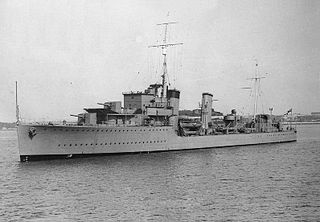 W
WHMS Kempenfelt was a C-class destroyer built for the Royal Navy in the early 1930s. A flotilla leader, she saw service in the Home Fleet before World War II and the ship made several deployments to Spanish waters during the Spanish Civil War, enforcing the arms blockade imposed by Britain and France on both sides of the conflict.
 W
WHMCS Athabaskan was the first of three destroyers of the Royal Canadian Navy to bear this name. It was a destroyer of the Tribal class, that served in the Second World War. She was named for the First Nations peoples who make up the Athabaskan language group. She was torpedoed in the English Channel and sunk in 1944.
 W
WUSS Edwards (DD-265) was a Clemson-class destroyer in the United States Navy and transferred to the Royal Navy where she served as HMS Buxton (H96) and later in the Royal Canadian Navy during World War II.
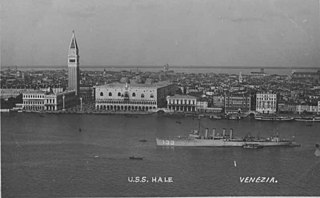 W
WThe first USS Hale (DD–133) was a Wickes-class destroyer in the United States Navy during World War I, later transferred to the Royal Navy as HMS Caldwell (I20). She was named for Senator Eugene Hale.
 W
WHMS Hero was an H-class destroyer built for the Royal Navy in the mid-1930s. During the Spanish Civil War of 1936–1939 the ship enforced the arms blockade imposed by Britain and France on both sides as part of the Mediterranean Fleet. During the first few months of World War II, Hero searched for German commerce raiders in the Atlantic Ocean and participated in the Second Battle of Narvik during the Norwegian Campaign of April–June 1940 before she was transferred to the Mediterranean Fleet in May where she escorted a number of convoys to Malta. The ship took part in the Battle of Cape Spada in July 1940, Operation Abstention in February 1941, and the evacuations of Greece and Crete in April–May 1941.
 W
WUSS Crowninshield (DD–134) was a Wickes-class destroyer in the United States Navy between World War I and World War II. She was named for Benjamin Williams Crowninshield. In World War II she was transferred to the Royal Navy where she was named HMS Chelsea, and subsequently to the Soviet Navy where she was named Derzkiy.
 W
WThe first USS Haraden (DD–183) was a Wickes-class destroyer in the United States Navy in the period following World War I. She was later transferred to the Royal Canadian Navy as HMCS Columbia, as a Town-class destroyer.
 W
WHMCS Crescent was a C-class destroyer that was built for the Royal Navy but was transferred before completion and saw active service with the Royal Canadian Navy. She was one of 32 destroyers of that class built between 1943 and 1945 as part of the War Emergency Programme.
 W
WHMS Crescent was a C-class destroyer which was built for the Royal Navy in the early 1930s. The ship was initially assigned to the Home Fleet, although she was temporarily deployed in the Red Sea and Indian Ocean during the Abyssinia Crisis of 1935–36. Crescent was sold to the Royal Canadian Navy in late 1936 and renamed HMCS Fraser. She was stationed on the west coast of Canada until the beginning of World War II when she was transferred to the Atlantic coast for convoy escort duties. The ship was transferred to the United Kingdom (UK) in May 1940 and helped to evacuate refugees from France upon her arrival in early June. Fraser was sunk on 25 June 1940 in a collision with the anti-aircraft cruiser HMS Calcutta while returning from one such mission.
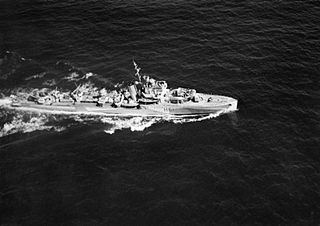 W
WHMS Express was an E-class minelaying destroyer built for the Royal Navy in the early 1930s. Although assigned to the Home Fleet upon completion, the ship was attached to the Mediterranean Fleet in 1935–36 during the Abyssinia Crisis. During the Spanish Civil War of 1936–39, she spent considerable time in Spanish waters, enforcing the arms blockade imposed by Britain and France on both sides of the conflict.
 W
WUSS Maddox (DD–168) was a Wickes-class destroyer in the United States Navy during World War I. She was later transferred to the Royal Navy as HMS Georgetown (I-40), to the Royal Canadian Navy as HMCS Georgetown, and then to the Soviet Navy as Doblestny . She was the last "four piper" destroyer to be scrapped.
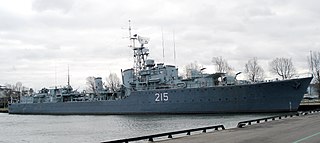 W
WHMCS Haida is a Tribal-class destroyer that served in the Royal Canadian Navy (RCN) from 1943 to 1963, participating in World War II and the Korean War. She was named for the Haida people.
 W
WThe first USS Kalk (DD–170) was a Wickes-class destroyer in the United States Navy during World War I, later transferred to the Royal Navy as HMS Hamilton (I24) and then into the Royal Canadian Navy as HMCS Hamilton (I24).
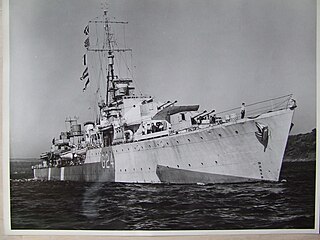 W
WHMCS Huron was a Tribal-class destroyer that served in the Royal Canadian Navy in the Second World War and the Korean War. She was the first ship to bear this name, entering service in 1943. She was named for the Huron people. During the Second World War the vessel saw service in Operation Neptune in the Bay of Biscay and along the French coast in support of the invasion of Normandy and escorted convoys to the Soviet Union. Following the war, the ship was placed in reserve. The destroyer was activated in 1950 as a training ship, but with the onset of the Korean War, was modernized and deployed twice to Korea. Following the war, Huron reverted to a training ship and took part in Cold War-era North Atlantic Treaty Organization (NATO) naval exercises until being paid off for the final time in 1963 and broken up for scrap in 1965.
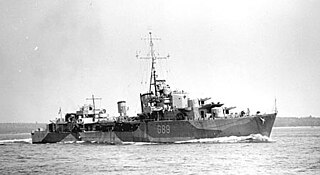 W
WHMCS Iroquois was a Tribal-class destroyer that served in the Royal Canadian Navy during the Second World War and Korean War. She was named for the Iroquois First Nations. Iroquois was the first ship to bear this name and the first ship of the class to serve with the Royal Canadian Navy.
 W
WHMS Decoy was a D-class destroyer of the Royal Navy. Ordered in 1931, the ship was constructed by John I. Thornycroft & Company, and entered naval service in 1933. Decoy was initially assigned to the Mediterranean Fleet before she was transferred to the China Station in early 1935. She was temporarily deployed in the Red Sea during late 1935 during the Abyssinia Crisis, before returning to her duty station where she remained until mid-1939. Decoy was transferred back to the Mediterranean Fleet just before the Second World War began in September 1939. She briefly was assigned to West Africa for convoy escort duties in 1940 before returning to the Mediterranean. The ship participated in the Battles of Calabria without significant damage and escorted ships of the Mediterranean Fleet for most of the rest of the year.
 W
WThe first USS Twiggs (DD–127) was a Wickes-class destroyer in the United States Navy during World War I. She was named for Major Levi Twiggs. She was later transferred to the Royal Navy, as HMS Leamington and to the Soviet Navy as Zhguchi, before returning to Britain to star in the film The Gift Horse, which depicts the St. Nazaire Raid.
 W
WThe first USS Yarnall (DD–143) was a Wickes-class destroyer in the United States Navy during World War I later transferred to the Royal Navy as HMS Lincoln, to the Royal Norwegian Navy as HNoMS Lincoln, and subsequently to the Soviet Navy as Druzhny.
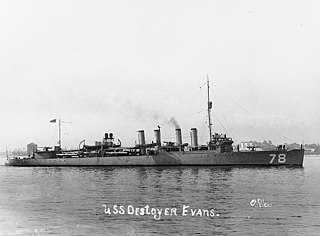 W
WThe first USS Evans (DD–78) was a Wickes-class destroyer in the United States Navy during World War I, later transferred to the Royal Navy as HMS Mansfield.
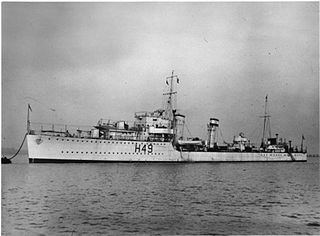 W
WHMS Diana was a D-class destroyer of the Royal Navy. Ordered in 1931, the ship was constructed by Palmers Shipbuilding and Iron Company, and entered naval service in 1932. Diana was initially assigned to the Mediterranean Fleet before she was transferred to the China Station in early 1935. She was temporarily deployed in the Red Sea during late 1935 during the Abyssinia Crisis, before returning to her duty station where she remained until mid-1939. Diana was transferred back to the Mediterranean Fleet just before the Second World War began in September 1939. She served with the Home Fleet during the Norwegian Campaign. The ship was transferred to the Royal Canadian Navy in 1940 and renamed HMCS Margaree. She served for just over a month with the Canadians before being sunk in a collision with a large freighter she was escorting on 22 October 1940.
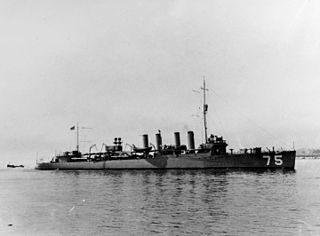 W
WThe first USS Wickes (DD-75) was the lead ship of her class of destroyers in the United States Navy during World War I, later transferred to the Royal Navy as HMS Montgomery. She has been the only ship of the Royal Navy to bear the name Montgomery.
 W
WThe first USS Thatcher (DD–162) was a Wickes-class destroyer in the United States Navy, later transferred to the Royal Canadian Navy as HMCS Niagara.
 W
WHMCS Nootka was a Tribal-class destroyer that served in the Royal Canadian Navy (RCN) from 1946 to 1964. Constructed too late to take part in the Second World War, the ship saw service in the Korean War. She received the unit name Nootka while still under construction in Halifax, Nova Scotia after the RCN renamed the Fundy-class minesweeper Nootka (J35) to Nanoose (J35) in 1943. Nootka was the second Canadian Tribal to be constructed in Canada and the second Canadian warship to circumnavigate the world. The ship was sold for scrap and broken up at Faslane, Scotland in 1965.
 W
WHMS Griffin (H31) was a G-class destroyer, built for the Royal Navy in the mid-1930s. In World War II she took part in the Norwegian Campaign of April–May 1940 and the Battle of Dakar in September before being transferred to the Mediterranean Fleet in November. She generally escorted larger ships of the Mediterranean Fleet as they protected convoys against attacks from the Italian Fleet. Griffin took part in the Battle of Cape Matapan in March 1941 and the evacuations of Greece and Crete in April–May 1941. In June she took part in the Syria-Lebanon Campaign and was escorting convoys and the larger ships of the Mediterranean Fleet until she was transferred to the Eastern Fleet in March 1942.
 W
WHMS Crusader was a C-class destroyer built for the Royal Navy in the early 1930s. She saw service in the Home and Mediterranean Fleets and spent six months during the Spanish Civil War in late 1936 in Spanish waters, enforcing the arms blockade imposed by Britain and France on both sides of the conflict. Crusader was sold to the Royal Canadian Navy (RCN) in 1938 and renamed HMCS Ottawa. She was initially deployed on the Canadian Pacific Coast before World War II, but was transferred to the Atlantic three months after the war began. She served as a convoy escort during the battle of the Atlantic until sunk by the German submarine U-91 on 14 September 1942. Together with a British destroyer, she sank an Italian submarine in the North Atlantic in November 1941.
 W
WHMS Foxhound was one of nine F-class destroyers built for the Royal Navy in the mid-1930s. Although she was assigned to the Home Fleet, the ship was detached as part of the Mediterranean Fleet to enforce the arms blockade imposed by Britain and France on both sides during the Spanish Civil War of 1936–39. Several weeks after the start of the Second World War in September 1939, Foxhound helped to sink a German submarine and participated in the Second Battle of Narvik during the Norwegian Campaign of April–June 1940. The ship was sent to Gibraltar in mid-1940 and formed part of Force H where she participated in the attack on Mers-el-Kébir. Foxhound escorted the aircraft carriers of Force H as they flew off aircraft for Malta and covered convoys resupplying and reinforcing the island until late 1941. During this time the ship helped to sink another German submarine.
 W
WHMS Comet was a C-class destroyer built for the Royal Navy in the early 1930s. She saw service in the Home and Mediterranean Fleets and the ship spent six months during the Spanish Civil War in late 1936 in Spanish waters, enforcing the arms blockade imposed by Britain and France on both sides of the conflict. Comet transferred to the Royal Canadian Navy (RCN) in 1938 and renamed HMCS Restigouche. During World War II, she served as a convoy escort in the battle of the Atlantic, on anti-submarine patrols during the invasion of Normandy, and was employed as a troop transport after VE Day for returning Canadian servicemen, before being decommissioned in late 1945. Restigouche was sold for scrap in 1946.
 W
WUSS Fairfax (DD-93) was a Wickes-class destroyer in the United States Navy during World War I, later transferred for World War II service first to the Royal Navy as HMS Richmond (G88), a Town-class destroyer, and then to the Soviet Navy as Zhivuchiy.
 W
WHMCS Saguenay was a River-class destroyer that served in the Royal Canadian Navy (RCN) from 1931–1945.
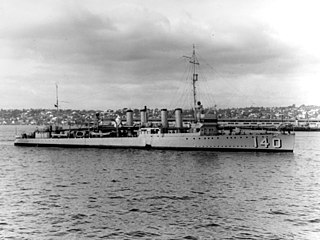 W
WUSS Claxton (DD-140), named for Thomas Claxton, was a Wickes-class destroyer in the United States Navy. Entering service in 1919, the destroyer saw intermittent use during the interwar period. During World War II, Claxton was transferred to the Royal Navy and renamed HMS Salisbury. The ship saw service in the Battle of the Atlantic before sold for scrapping in 1944.
 W
WHMS Fortune was one of nine F-class destroyers built for the Royal Navy in the mid-1930s. Although she was assigned to the Home Fleet upon completion, the ship was detached to the Mediterranean Fleet to enforce the arms blockade imposed by Britain and France on both sides during the Spanish Civil War of 1936–39. Several weeks after the start of the Second World War in September 1939, Fortune helped to sink a German submarine. The ship escorted the larger ships of the fleet during the early stages of World War II and played a minor role in the Norwegian Campaign of 1940. Fortune was sent to Gibraltar in mid-1940 and formed part of Force H where she participated in the Battle of Dakar against the Vichy French. The ship escorted numerous convoys to Malta in 1940–41 until she was badly damaged by Italian bombers in mid-1941.
 W
WHMCS Sioux was a V-class destroyer of the Royal Canadian Navy which fought in the Second World War and the Korean War. She was launched as HMS Vixen for the British Royal Navy before being transferred to the Royal Canadian Navy. She was then named for the Sioux people of Canada's western provinces.
 W
WHMCS Skeena was a River-class destroyer that served in the Royal Canadian Navy from 1931-1944.
 W
WUSS Williams (DD-108) was a Wickes-class destroyer in the United States Navy entering service in 1919, and was the second ship to bear the name. Following a brief stint in active service, the ship was laid up for 17 years before being reactivated during World War II. Williams transferred to the Royal Canadian Navy during World War II as part of Lend-Lease and was renamed HMCS St. Clair (I65), surviving the war and being scrapped in 1946.
 W
WThe second USS Bancroft (DD-256) was a Clemson-class destroyer in the United States Navy, which briefly served in 1919. Placed in reserve, the ship lay idle before being reactivated for World War II. She was transferred to the Royal Canadian Navy in 1940, where she served as HMCS St. Francis (I93) in the Battle of the Atlantic escorting convoys. The ship was declared surplus in April 1945, sold for scrap and sank on the way to the breakers after a collision in July.
 W
WHMS Cygnet was a C-class destroyer built for the Royal Navy in the early 1930s. The ship was initially assigned to the Home Fleet, although she was temporarily deployed in the Red Sea during the Abyssinia Crisis of 1935–36. Cygnet was sold to the Royal Canadian Navy (RCN) in late 1937 and renamed HMCS St. Laurent. She was stationed on the west coast of Canada when World War II began in September 1939, and had to be transferred to the Atlantic coast for convoy escort duties. She served as a convoy escort in the Battle of the Atlantic and participated in the sinking of two German submarines. The ship was on anti-submarine patrols during the invasion of Normandy, and was employed as a troop transport after VE Day for returning Canadian servicemen. St. Laurent was decommissioned in late 1945 and scrapped in 1947.